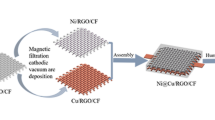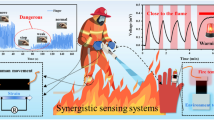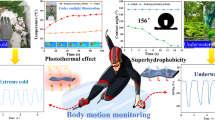Abstract
Fabric-based flexible sensors prepared from carbon materials as conductive media have promising prospects in human motion detection, gesture recognition, and telemedicine services. Their electro-mechanical properties are influenced by the microscopic nanostructure of the carbon material and the type of fabric substrate. However, choosing suitable carbon materials to fabricate strain sensors for joint movement monitoring has received little attention. In this work, we selected cotton knitted fabrics (CKF) with structures of plain, 1 × 1 rib and 2 × 2 rib as a flexible substrate and reduced graphene oxide (rGO), carboxylic multi-wall carbon nanotubes (c-MWCNTs), and carbon black (CB) as the conductive medium using a scalable impregnation method to prepare rGO/CKF, c-MWCNTs/CKF, and CB/CKF sensors respectively. The electro-mechanical characteristics of the three-carbon material decorated fabric sensors were investigated and compared. The different structures’ knitted fabric sensors showed a bimodal curve under the stretch-release cycle at large elongation. The resistance models were developed to explain the bimodal phenomenon. Among three carbon materials, the fabric sensor made by graphene as a conductive material has the best electro-mechanical property. The rGO/CKF sensors showed highly stretchable and durable performance for joint activity monitoring, capable of being applied in smart clothes.
Graphical abstract







Similar content being viewed by others
References
Aydın M, Aydın EB, Sezgintürk MK (2018) A highly selective electrochemical immunosensor based on conductive carbon black and star PGMA polymer composite material for IL-8 biomarker detection in human serum and saliva. Biosens Bioelectron 117:720–728. https://doi.org/10.1016/j.bios.2018.07.010
Bandari SSM, Asayesh A, Latifi M (2020) The effect of fabric structure and strain percentage on the tensile stress relaxation of rib weft knitted Fabrics. Fibers Polym 21:921–929. https://doi.org/10.1007/s12221-020-9450-6
Cai G, Xu Z, Yang M et al (2017a) Functionalization of cotton fabrics through thermal reduction of graphene oxide. Appl Surf Sci 393:441–448. https://doi.org/10.1016/j.apsusc.2016.10.046
Cai G, Yang M, Xu Z et al (2017b) Flexible and wearable strain sensing fabrics. Chem Eng J 325:396–403. https://doi.org/10.1016/j.cej.2017.05.091
Chen J, Yu Q, Cui X et al (2019) An overview of stretchable strain sensors from conductive polymer nanocomposites. J Mater Chem C 7:11710–11730. https://doi.org/10.1039/c9tc03655e
Cherenack K, Zysset C, Kinkeldei T et al (2010) Woven electronic fibers with sensing and display functions for smart textiles. Adv Mater 22:5178–5182. https://doi.org/10.1002/adma.201002159
Deng J, Zhuang W, Bao L et al (2019) A tactile sensing textile with bending-independent pressure perception and spatial acuity. Carbon N Y 149:63–70. https://doi.org/10.1016/j.carbon.2019.04.019
Duan Q, Lu Y (2021) Silk sericin as a green adhesive to fabricate a textile strain sensor with excellent electromagnetic shielding performance. ACS Appl Mater Interfaces 13:28832–28842. https://doi.org/10.1021/acsami.1c05671
Englert JM, Vecera P, Knirsch KC et al (2013) Scanning-Raman-microscopy for the statistical analysis of covalently functionalized graphene. ACS Nano 7:5472–5482. https://doi.org/10.1021/nn401481h
Fang Y, Zhang Y, Miao C et al (2020) MXene-derived defect-rich TiO2@rGO as high-rate anodes for full Na Ion batteries and capacitors. Nano-Micro Lett 12:128. https://doi.org/10.1007/s40820-020-00471-9
Feng J, Wang X, Lv Z et al (2020) Multifunctional wearable strain sensor made with an elastic interwoven fabric for patients with motor dysfunction. Adv Mater Technol 5:2000560. https://doi.org/10.1002/admt.202000560
Fromme NP, Li Y, Camenzind M et al (2021) Metal-textile laser welding for wearable sensors applications. Adv Electron Mater 7:2001238. https://doi.org/10.1002/aelm.202001238
He Q, Lv J, Xu H et al (2019) Enhancing electrical conductivity and electrical stability of polypyrrole-coated cotton fabrics via surface microdissolution. J Appl Polym Sci 136:47515. https://doi.org/10.1002/app.47515
Homayounfar SZ, Rostaminia S, Kiaghadi A et al (2020) Multimodal smart eyewear for longitudinal eye movement tracking. Matter 3:1275–1293. https://doi.org/10.1016/j.matt.2020.07.030
Hong J, Pan Z, Zhewang et al (2016) A large-strain weft-knitted sensor fabricated by conductive UHMWPE/PANI composite yarns. Sens Actuators Phys 238:307–316. https://doi.org/10.1016/j.sna.2015.12.028
Karim N, Afroj S, Tan S et al (2017) Scalable production of graphene-based wearable E-textiles. ACS Nano 11:12266–12275. https://doi.org/10.1021/acsnano.7b05921
Liang X, Li H, Dou J et al (2020) Stable and biocompatible carbon nanotube ink mediated by silk protein for printed electronics. Adv Mater 32:2000165. https://doi.org/10.1002/adma.202000165
Liu R, Liu C, Fan S (2017) A photocapacitor based on organometal halide perovskite and PANI/CNT composites integrated using a CNT bridge. J Mater Chem A 5:23078–23084. https://doi.org/10.1039/c7ta06297d
Liu K, Yu J, Li Y et al (2019) Carbon black from diesel soot for high-performance wearable pressure sensors. Adv Mater Technol 4:1900475. https://doi.org/10.1002/admt.201900475
Liu Z, Chen K, Fernando A et al (2021) Permeable graphited hemp fabrics-based, wearing-comfortable pressure sensors for monitoring human activities. Chem Eng J 403:126191. https://doi.org/10.1016/j.cej.2020.126191
Lv J, Liu Z, Zhang L et al (2022) Multifunctional polypyrrole and rose-like silver flower-decorated E-textile with outstanding pressure/strain sensing and energy storage performance. Chem Eng J 427:130823. https://doi.org/10.1016/j.cej.2021.130823
Mahar TJ, Wang H, Postle R (2013) A review of fabric tactile properties and their subjective assessment for next-to-skin knitted fabrics. J Text Inst 104:572–589. https://doi.org/10.1080/00405000.2013.774947
McCartney J, Hinds BK, Seow BL, Gong D (2000) Dedicated 3D CAD for garment modelling. J Mater Process Technol 107:31–36. https://doi.org/10.1016/S0924-0136(00)00695-6
Nandgaonkar AG, Wang Q, Fu K et al (2014) A one-pot biosynthesis of reduced graphene oxide (RGO)/bacterial cellulose (BC) nanocomposites. Green Chem 16:3195–3201. https://doi.org/10.1039/C4GC00264D
Niu B, Yang S, Tian X, Hua T (2021) Highly sensitive and stretchable fiber strain sensors empowered by synergetic conductive network of silver nanoparticles and carbon nanotubes. Appl Mater Today 25:101221. https://doi.org/10.1016/j.apmt.2021.101221
Poincloux S, Adda-Bedia M, Lechenault F (2018) Geometry and elasticity of a knitted Fabric. Phys Rev X 8:021075. https://doi.org/10.1103/PhysRevX.8.021075
Price EK, Bansala T, Achee TC et al (2019) Tunable dispersibility and wettability of graphene oxide through one-pot functionalization and reduction. J Colloid Interface Sci 552:771–780. https://doi.org/10.1016/j.jcis.2019.05.097
Qi B, He X, Zeng G et al (2017) Strict molecular sieving over electrodeposited 2D-interspacing-narrowed graphene oxide membranes. Nat Commun 8:825. https://doi.org/10.1038/s41467-017-00990-x
Qi K, Zhou Y, Ou K et al (2020) Weavable and stretchable piezoresistive carbon nanotubes-embedded nanofiber sensing yarns for highly sensitive and multimodal wearable textile sensor. Carbon N Y 170:464–476. https://doi.org/10.1016/j.carbon.2020.07.042
Raj S, Sreenivasan S (2009) Total wear comfort index as an objective parameter for characterization of overall wearability of cotton fabrics. J Eng Fiber Fabr 4:29–41. https://doi.org/10.1177/155892500900400406
Ramulu B, Chandra Sekhar S, Arbaz SJ, Yu JS (2021) Nano-Ag laminated ternary layered double hydroxides for hybrid supercapacitors. Chem Eng J 420:130376. https://doi.org/10.1016/j.cej.2021.130376
Sarpong LK, Bredol M, Schönhoff M (2017) Heteroaggregation of multiwalled carbon nanotubes and zinc sulfide nanoparticles. Carbon N Y 125:480–491. https://doi.org/10.1016/j.carbon.2017.09.067
Shen H, Jiang C, Li W et al (2021) Synergistic photodynamic and photothermal antibacterial activity of in situ grown bacterial cellulose/MoS2-chitosan nanocomposite materials with visible light illumination. ACS Appl Mater Interfaces 13:31193–31205. https://doi.org/10.1021/acsami.1c08178
Si Y, Park JW, Jung S et al (2019) Voltammetric layer-by-layer biosensor featuring purine nucleoside phosphorylase and chitosan for inosine in human serum solutions. Sens Actuators B Chem 298:126840. https://doi.org/10.1016/j.snb.2019.126840
Souri H, Bhattacharyya D (2018) Highly sensitive, stretchable and wearable strain sensors using fragmented conductive cotton fabric. J Mater Chem C 6:10524–10531. https://doi.org/10.1039/C8TC03702G
Tiwari JN, Tiwari RN, Kim KS (2012) Zero-dimensional, one-dimensional, two-dimensional and three-dimensional nanostructured materials for advanced electrochemical energy devices. Prog Mater Sci 57:724–803. https://doi.org/10.1016/j.pmatsci.2011.08.003
Tokarska M, Orpel M (2019) Study of anisotropic electrical resistance of knitted fabrics. Text Res J 89:1073–1083. https://doi.org/10.1177/0040517518763978
Wang C, Xia K, Wang H et al (2019) Advanced Carbon for Flexible and Wearable Electronics. Adv Mater 31:1801072. https://doi.org/10.1002/adma.201801072
Wang W, Guo J, Liu X et al (2020) Constructing eco-friendly flame retardant coating on cotton fabrics by layer-by-layer self-assembly. Cellulose 27:5377–5389. https://doi.org/10.1007/s10570-020-03140-7
Wu Z, Wang Y, Liu X et al (2019) Carbon-nanomaterial-based flexible batteries for wearable electronics. Adv Mater 31:1800716. https://doi.org/10.1002/adma.201800716
Xie H, Geng Q, Zhu X et al (2019) PdP2 nanoparticles-reduced graphene oxide for electrocatalytic N2 conversion to NH3 under ambient conditions. J Mater Chem A 7:24760–24764. https://doi.org/10.1039/c9ta09910g
Yan T, Wang Z, Pan ZJ (2018) A highly sensitive strain sensor based on a carbonized polyacrylonitrile nanofiber woven fabric. J Mater Sci 53:11917–11931. https://doi.org/10.1007/s10853-018-2432-z
Yang Z, Pang Y, Han X et al (2018) Graphene textile strain sensor with negative resistance variation for human motion detection. ACS Nano 12:9134–9141. https://doi.org/10.1021/acsnano.8b03391
Yu Q, Weng P, Han L et al (2019) Enhanced thermal conductivity of flexible cotton fabrics coated with reactive MWCNT nanofluid for potential application in thermal conductivity coatings and fire warning. Cellulose 26:7523–7535. https://doi.org/10.1007/s10570-019-02592-w
Zhang S, Yang X, Tang B et al (2018) New insights into synergistic antimicrobial and antifouling cotton fabrics via dually finished with quaternary ammonium salt and zwitterionic sulfobetaine. Chem Eng J 336:123–132. https://doi.org/10.1016/j.cej.2017.10.168
Zhang L, Wang Y, Niu Z, Chen J (2019a) Advanced nanostructured carbon-based materials for rechargeable lithium-sulfur batteries. Carbon N Y 141:400–416. https://doi.org/10.1016/j.carbon.2018.09.067
Zhang Y, Heo YJ, Son YR et al (2019) Recent advanced thermal interfacial materials: a review of conducting mechanisms and parameters of carbon materials. Carbon N Y 142:445–460. https://doi.org/10.1016/j.carbon.2018.10.077
Zhang Y, Ren E, Tang H et al (2020) Carbon nanotubes/acetylene black/ecoflex with corrugated microcracks for enhanced sensitivity for stretchable strain sensors. J Mater Sci Mater Electron 31:14145–14156. https://doi.org/10.1007/s10854-020-03969-5
Zhang L, Yu Y, Zheng S et al (2021a) Preparation and properties of conductive bacterial cellulose-based graphene oxide-silver nanoparticles antibacterial dressing. Carbohydr Polym 257:117671. https://doi.org/10.1016/j.carbpol.2021.117671
Zhang Z, Xiao X, Zhou Y et al (2021b) Bioinspired graphene oxide membranes with pH-responsive nanochannels for high-performance n anofiltration. ACS Nano 15:13178–13187. https://doi.org/10.1021/acsnano.1c02719
Zheng L, Zhu M, Wu B et al (2021) Conductance-stable liquid metal sheath-core microfibers for stretchy smart fabrics and self-powered sensing. Sci Adv 7:4041. https://doi.org/10.1126/sciadv.abg4041
Zhou X, Hu C, Lin X et al (2021) Polyaniline-coated cotton knitted fabric for body motion monitoring. Sens Actuators Phys 321:112591. https://doi.org/10.1016/j.sna.2021.112591
Funding
This work was financially supported by Natural Science Foundation of Jiangxi Province, China (No. 20212BAB214016), the National Natural Science Foundation of China (No. 51603090), China Postdoctoral Science Foundation (No. 2018M630516), International Science and Technology Center (No. BZ2018032).
Author information
Authors and Affiliations
Corresponding author
Ethics declarations
Conflict of interest
All authors have declare that they have no conflict of interest.
Additional information
Publisher’s Note
Springer Nature remains neutral with regard to jurisdictional claims in published maps and institutional affiliations.
Electronic supplementary material
Below is the link to the electronic supplementary material.
Supplementary Material 1
Rights and permissions
About this article
Cite this article
Lu, D., Liao, S., Wei, Q. et al. Comparative study of different carbon materials for the preparation of knitted fabric sensors. Cellulose 29, 7431–7444 (2022). https://doi.org/10.1007/s10570-022-04722-3
Received:
Accepted:
Published:
Issue Date:
DOI: https://doi.org/10.1007/s10570-022-04722-3




